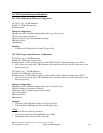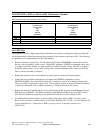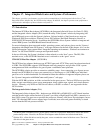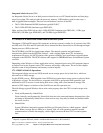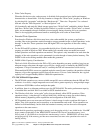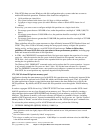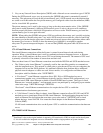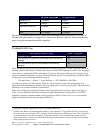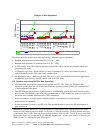
y With iSCSI, there are some Windows side disk configuration rules you must take into account to
enable efficient disk operations. Windows disks should be configured as:
1 disk partition per virtual drive.
File system formatted with cluster sizes of 4 kbyte or 4 kbyte multiples.
2 gigabyte or larger storage spaces (for which Windows creates a default NTFS cluster size of
4kbytes).
If necessary, you can use care to configure multiple disk partitions on a single virtual drive.
y For storage spaces that are 1024 MB or less, make the partitions a multiple of 1 MB (1,048,576
bytes).
y For storage spaces that are 511000 MB or less, the partition should be a multiple of 63 MB
(66060288 bytes).
y For storage spaces that are greater than 511000 MB, the partition should be a multiple of 252 MB
(264,241,152 bytes)
.
These guidelines allow file system structures to align efficiently between iSCSI Windows/Linux and
i5/OS
7
. They allow i5/OS to efficiently manage the storage space memory, mitigate disk operation
faulting activity, and thus improve overall iSCSI disk I/O performance. Failure to follow these
guidelines will cause iSCSI disk write operations to incur performance penalties, including page
faults and increased serialization of disk operations.
y In V5R4 – the CHGNWSSTG command and iSeries Navigator now supports the expansion of a storage
space size. After the expansion, the file system in the disk should also be expanded - but take care on
iSCSI disks: don’t create a new partition in the expanded disk free space (unless the new partitions
meeting the size guidelines above).
The Windows 2003 “DISKPART” command can be used to perform the file system expansion – however
it only actually expands the file system on “basic” disks. If a disk has been converted to a “dynamic”
disk
8
, the DISKPART command creates a new partition and configures a spanned set across the partitions.
With iSCSI, the second partition may experience degraded disk performance.
17.2.3 iSCSI virtual I/O private memory pool
Applications sharing the same memory pool with iSCSI disk operations may be adversely impacted if the
iSCSI network servers perform levels of disk I/O which can flush the memory pool. Thus, it is possible
for other applications to begin to page fault because their memory has been flushed out to disk by the
iSCSI operations. By default, the iSCSI virtual disk I/O operations occur through the *BASE memory
pool.
In order to segregate iSCSI disk activity, V5R4 PTF SI23027 has been created to enable iSCSI virtual
disk I/O operations to run out of an allocated private memory pool. The pool is enabled by creating a
subsystem description named QGPL/QFPHIS and allocating a private memory pool of at least 4096
kilobytes. The amount of memory you want to allocate will depend on a number of factors, including
number of iSCSI network servers, expected sustained disk activity for all servers, etc. See the “System i
Memory Rules of Thumb” section below for more guidelines on the “iSCSI private pool” minimum size.
To activate the private memory pool for all iSCSI network servers, perform the following:
1. CRTSBSD SBSD(QGPL/QFPHIS) POOLS((1 10000 1))
9
IBM i 6.1 Performance Capabilities Reference - January/April/October 2008
© Copyright IBM Corp. 2008 Chapter 17 - Integrated BladeCenter and System x Performance 283
9
Pick a larger or smaller pool size as appropriate. 10,000 KByte is a reasonable minimum value, but 4096 KByte
is the absolute minimum supported.
8
Not to be confused with “dynamically linked” storage spaces.
7
These guidelines could also slightly improve IXS and IXA attached servers’ disk performance, but to a much
smaller degree.





